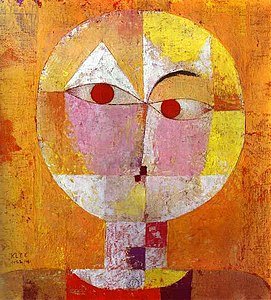Senecio (Paul Klee)

|
| Senecio (Baldgreis) |
|---|
| Paul Klee , 1922 |
| Oil on chalk primer on gauze on cardboard |
| 40.3 x 37.4 cm |
| Art Museum Basel |
Senecio (Baldgreis) is one of the most famous paintings by Paul Klee . It dates from 1922 and was created when the artist was a teacher at the state Bauhaus in Weimar. In its composition, the picture shows influences from the African mask and doll culture as well as the formal language postulated by Wassily Kandinsky at the Bauhaus, consisting of square, triangle and circle. The picture was bought by the Kunstmuseum Basel in 1931 and has been in the “Art of the 20th Century” collection there ever since.
Description and interpretation
According to some art historians, the title of the picture “Senecio” refers to the plant Senecio vulgaris , the common ragwort , because the herb has similarly round fruit heads. The addition “Baldgreis” could mean both an allusion to a literal translation, but also a humorous allusion to the sitter's early aging. In the simple geometric shapes of square, triangle and circle, with the inaccuracy typical of Klee, he painted a flat, disk-like face, which, however, has precursors in earlier motifs of his work. He was familiar with the African culture of dolls and masks. Therefore the reference to the design language of the Bauhaus is not necessarily to be seen here alone. In addition, Klee did not use the primary colors that were later associated with the Bauhaus , but rather his own delicate and warm tones. The drawing of the eyes in particular has sharp lines that make them stand out. Similar sharply contoured eyes are also present in his painting Cat and Bird ( Museum of Modern Art , New York) from 1928. Klee's way of connecting eyes with a continuous curved line during that creative period was explained in more detail in his educational sketchbook in 1924/1925 with a drawing. In this work, published as a Bauhaus book, Volume 2 , he differentiates between active , medial and passive lines. Triangles are set above the right eye of this portrait, showing the one-sided raising of the brow. There are semicircles above the other eye, which is a little lower down. The neck and cheeks consist of the colored squares known to Klee since his trip to Tunis .
In addition to African influences, the art historian Jim M. Jordan also recognizes Pablo Picasso's portrait of Wilhelm Uhde , Marc Chagall's Le soldat boit and the well-known emblem for the Bauhaus by Oskar Schlemmer , all of which have a resemblance to the flat faces of West African dolls of the Ashanti , who “probably knew” Klee. As a Bauhaus teacher, that was his special field, he represented the “archetypal forms of the organic”, to which the circular shape of this face belongs, and was against the “premature definition of the form” of an image. Long before that , Klee had a positive, albeit distant, view of Cubism , as represented by Picasso. In Senecio , some observers recognize elements of this cubism. The art historian Carola Giedion-Welcker describes the portrait as “slightly humanized”, she finds it “amazing how a simple round shape with red eye circles, indicated nose vertical and small blue-purple rectangles in the mouth area receives the psychological intensity and the mood of the human face ".
Exhibition (selection)
- End of May to end of August 1924: Exhibition of new German art. Art building on Schlossplatz, Stuttgart
- May to June 1925: Paul Klee. 2. Complete exhibition. New Art Gallery - Hans Goltz, Munich
- April 20 to May 9, 1929: Bauhaus Dessau: J. Albers, L. Feininger, W. Kandinsky, P. Klee, O. Schlemmer. Kunsthalle Basel.
- March 23 to July 28, 2002: Paul Klee, works on paper from the Kupferstichkabinett Basel
reception
Since Paul Klee's pictures and drawings in their reduced geometric forms always contain a childlike element and the artist himself also had educational ambitions and valued children's drawings, pictures like this are interesting for art lessons in schools. There are also teaching materials and elementary school books for viewing and designing this painting with its easily comprehensible forms:
- Image viewing in elementary school. … Paul Klee: Senecio: Class 1; with poster . 1st edition. Primary school hours Verlag, Schwarzenbruck 2009, ISBN 978-3-940253-23-1 .
- Carolin Kautza: Art Primary School: Paul Klee "Senecio". Image viewing and further development (class 2): Lesson design Saarland . GRIN Verlag, 2014, ISBN 978-3-656-61183-7 .
literature
- Public art collection Basel, annual reports 1931–1932. NF 28-29. Birkhäuser, Basel 1933, pp. 5, 13.
- Katharina Katz: Public Art Collection Basel. 20th century . Public art collection, Basel 1997, ISBN 3-7204-0108-1 , p. 134 .
- Christiane Weidemann: Paul Klee. The life story . Prestel Verlag, Munich / London / New York, NY 2011, ISBN 978-3-7913-7049-1 .
Web links
Individual evidence
- ^ Paul Klee: Pedagogical Sketchbook. Gebr. Mann Verlag , Berlin 2003 (reprint), ISBN 3-7861-1458-7 , p. 11
- ^ Kunstmuseum Basel - Online Collection - Senecio (Baldgreis). sammlungonline.kunstmuseumbasel.ch, accessed on January 5, 2019 (with detailed description and interpretation).
- ↑ Senecio - Paul Klee on Paul-Klee.org.
- ^ Norbert Lynton: Paul Klee. Introduced and explained by Norbert Lynton. Spring Books, London 1964, p. 41.
- ↑ "artsy.net" Alexxa Gotthardt to Cubist elements in the image.
- ↑ Carola Giedion-Welcker : Paul Klee in self-testimonies and image documents. Rowohlt's monographs, Reinbek 1961, pp. 69 and 111.
- ^ Exhibition of new German art. Kunstanstalt U. Levi, Stuttgart 1924, p. 14, no. 89.
- ^ Paul Klee. 2. Complete exhibition 1920/1925. Hans Goltz, Munich 1925, No. 14.
- ↑ exhibition catalog. Kunsthalle Basel 1929, p. 8, No. 93.
- ^ Kunstmuseum Basel: Exhibitions 2002.
- ↑ Werner Haftmann : Pedagogical Sketchbook (= ways of pictorial thinking: Klee ). Fischer Bücherei 1961, p. 73 ff.
